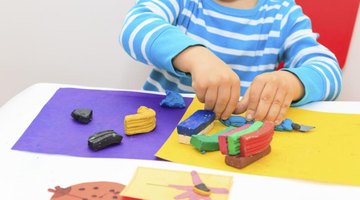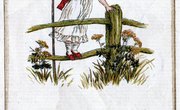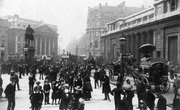"The Little Engine That Could" was written by Watty Piper and published in 1930. The story is about a train engine who doesn't think he can pull a long train of cars over a steep mountain. He convinces himself that he can by repeating, "I think I can. I think I can." Kindergarten lessons should focus on train-related activities and themes that center on courage, perseverance and hope.
"Difficult Task" Wall Chart
Discuss perseverance by creating a classroom wall chart of difficult tasks, suggests Jessica Circle, kindergarten teacher at Campbell Park Elementary School in Florida. Read the story aloud and pass out a blank sticky note to each student. Write "I Think I Can" at the top of a piece of poster board and tape the board to the wall at students' eye level. Have each student write a phrase or draw a picture of a difficult task, such as learning to read or to tie shoelaces, on her sticky note. Ask students to come up, one of the time, and attach their sticky note to the poster board. Discuss ways students might be able to accomplish those difficult tasks without giving up.
Happy and Sad Stick Puppets
Help your students understand the literary terms "tone" and "mood" by focusing on specific events in the story, such as Little Engine's disappointment and eventual success. Before class, make two 4-inch paper circles for each student and glue each circle to a wooden tongue depressor -- similar to stick puppets. Ask your students to draw a happy smiley face on one and a sad frowning face on the other, suggest teachers on the Scholastic website. Read the story aloud and pause briefly after each major event. Ask students to hold up their happy or sad face to describe how they felt after hearing that part of the story.
Little Engine's Role
Teach your class about the climax of the story by re-enacting it as a group. Organize your classroom chairs into one long line, and have students take turns sitting in the front seat to play the role of Little Engine. Instruct the lead student to rotate his arms slowly beside his chair -- like wheels -- and repeat the words "I think I can. I think I can." The other students should say the words with him in unison and follow his arm movements using the same tempo. Instruct the lead student to slur the words, as if the train were in slow motion, and move his arms slowly as the train struggles to get up the pretend hill. He can speed up the tempo on his way down. Blow a wooden train whistle or play a prerecorded whistle as the train comes to a stop and a new student takes the lead position.
Salt Dough Trains
Have your students make individual trains out of salt dough and discuss that it might be a hard task, but you know they can do it. Tell them that you're not going to provide molds or cubes, and they must make the trains on their own, without any tools. Show them how they can make squares and rectangles with their hands and put dough balls on the four corners for wheels. They can also make a steam chimney on top of the train engine. The goal is to reinforce themes about perseverance. Play the audio version of the story aloud as your students work on their salt dough trains.
Related Articles
References
Writer Bio
As curriculum developer and educator, Kristine Tucker has enjoyed the plethora of English assignments she's read (and graded!) over the years. Her experiences as vice-president of an energy consulting firm have given her the opportunity to explore business writing and HR. Tucker has a BA and holds Ohio teaching credentials.











